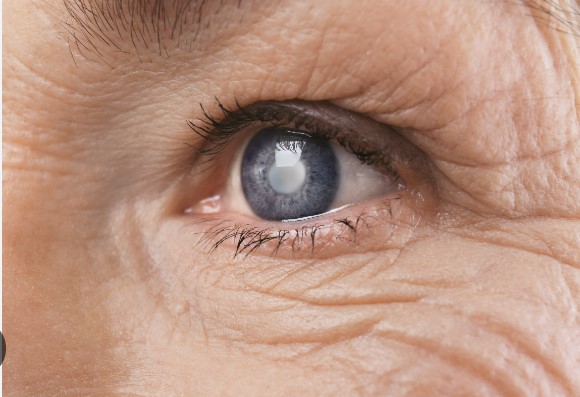Proper Nutrition and Dry Eyes
Michael P. Lange OD, CNS, 10/24/2011
Dry eyes can be improved through proper nutrition. The vast majority of dry eye patients will notice a significant improvement in dry eye symptoms once the correct dietary and lifestyle modifications are implemented. Dry eye is a nutritionally responsive condition and this paper will discuss how proper diet and supplementation may improve subjective and objective signs and symptoms of dry eyes.
Most of our patients, whether fat or thin, are nutritionally compromised. Very rarely will you meet a patient that is of ideal body weight, medication free and on a truly healthful diet. As a clinician you will know at the first glance of your patient and after a brief discussion how critical a dramatic adjustment in their diet is going to be to their overall health and their dry eyes. Proper nutrition is one of the most important single factors in maintaining the health of our patients. Most people in today’s society are not getting the required vitamins, minerals and essential fatty acids from the foods they are eating. We have become a society living ‘life on the go’ that is fueled by fast food and junk food. Our typical diet is caloric dense and nutrient deficient. Americans consume a diet that is unbalanced—with too many omega-6 fatty acids and not enough omega-3 fatty acids—leading to increased inflammation and disease in the body. This is associated with increased levels of cytokines, proteins that trigger inflammation. Inflammation is one of the root causes of dry eye syndrome (keratoconjunctivitis sicca) and many other systemic diseases. Our foods are processed, sugar- and salt-laden, filled with trans fats, hydrogenated oils, high fructose corn syrup, synthetic dyes, chemicals and artificial sweeteners. These poor nutritional habits combined with a sedimentary lifestyle are why the health of the American people (our patients) is becoming compromised. America is home to the most obese people in the world. According to the CDC (Center for Disease Control and Prevention) obesity in adults has increased by 60% within the past twenty years. A staggering 70% of American adults are overweight or obese and obesity related deaths have accelerated to more than 300,000 a year, second only to tobacco related deaths.
Dietary modifications and lifestyle changes

Dr. Lange recommends everyone learn the ‘dirty dozen’ fruits and vegetables
Most nutritional experts recommend 10-13 servings of organically grown fruits and vegetables a day. Americans are falling short of this amount and are becoming more and more nutritionally compromised. 70% of adults are not even consuming five portions of fruits and vegetables a day. The population that consumes the least amount of vegetables and fruits are more predisposed in developing disease and illness. These large and growing groups of people are nutritionally compromised and more prone to develop free radical damage in their bodies and eyes. These are the patients who are more prone to have dry eyes, cataracts and retinal disease. I have seen in clinical practice for close to twenty years the positive effects dietary modifications and lifestyle changes can have directly on ocular health and total body health.
I have finally come to the realization that patients who will follow a combination of the Mediterranean, paleo or hunter gatherer type of diet, eating more like our ancestors, along with regular exercise and proper sleep benefit significantly. This is a diet that consists of organically grown fruits, vegetables, seeds, nuts, whole grains, proteins and mainly water and a few other beverages. I recommend patients avoiding water that is in plastic bottles and drinking water that is filtered or in glass bottles due to the potential for bisphenols leaching into the water from the plastic. Bisphenols cause endocrine disruption which will compound a dry eye problem. Bisphenols are in plastic bottles as well as in canned foods. F, D and C red yellow and blue dye can also cause endocrine disruption and so should be avoided. Dyes are in just about everything we consume these days, so teach your patients to be proactive in their health and read labels. I recommend patients try to consume half their body weight in ounces of good quality water daily. I also advise patients to try to substitute their morning coffee with organic green tea and lemon. The antioxidant and anti inflammatory effects of green tea and lemon have significant health benefits and many of my patients will notice symptomatic relief of their dry eyes from this one simple step. I advise my patients to try to eat 10-13 servings of fruits and vegetables on a daily basis. I recommend “the dirty dozen” fruits and vegetables be only organically grown due to their high amounts of pesticide found inside this specific group. Most of us have an accumulated build up of pesticide exposure in our bodies due to numerous years of exposure. This “chemical burden” leads to a variety of serious health issues that may potentiate a dry eye condition. The protein in this particular type of diet should always be free range organically raised or wild, not farm raised! Try to get your patients to eat fish at least three times per week to improve the omega three to omega 6 ratio in their blood. The fish that is highest in omega three and lowest in potential contaminants are sardines, anchovies, herring, mackerel, wild rainbow trout and wild Alaskan salmon. Some of your patients will follow your directions precisely; however the majority is going to wonder off of these specific recommendations. This is why supplementation with antioxidants and omega-3 fatty acids is so important.
Blood chemistry testing
How do you know the specific nutritional status of your patients without testing them? The only accurate way to test for these deficiencies is through blood testing. We will routinely do three special blood tests to gain valuable insight into the nutritional health of our patients. A SpectraCell intracellular blood test, vitamin D 25 OH and an omega-3 index test will help determine what your patient’s nutritional status is and if they have nutritionally modifiable risk factors for ocular conditions like dry eyes. You will quickly see that almost everyone you test is deficient in antioxidants and omega three. Many of these patients will also have elevated CRP, homocystein, triglycerides, cholesterol and arachidonic acid. The majority of these blood chemistries can be positively impacted through proper nutrition. The poor results on these tests can help motivate your patients to making these crucial dietary and lifestyle modifications that will positively impact their overall health. After reviewing the results of these tests with your patients they will finally understand the benefit of proper supplementation. Realistically, due to these tests not being covered by Medicare or insurance, not everyone will be able to have these tests done because of the cost. Let’s now review the specific protocol that is working extremely well with the dry eye population.
Omega-3 fish oil
The majority of large clinical studies that have documented the positive health benefits of omega-3 fatty acids have utilized fish or fish oil consumption. There is a multitude of positive studies supporting the beneficial health aspects of a higher consumption of omega-3 from fish oil or fish. The medical community has readily embraced these positive health benefits and is prescribing and recommending fish oil supplements to their patients. The increased public awareness regarding omega 3 fish oil has created an omega-3 explosion. Consumers that are in tune with prevention and wellness are becoming proactive in their health and practicing prevention by consuming more fish or purchasing fish oil supplements from the drug store, health food store or through the Internet. However, one must be careful with consuming too much fish because of the potential contaminants that are in particular types of fish. With all of the contamination in the oceans it is becoming more and more difficult to recommend consuming large amounts of fish. The consumer or patient must also be aware that all fish oil is not created equal! The health care professional should be educating their patients on the benefits of proper omega-3 supplementation.
Fish Oil Demo with Dr Michael Lange
Ethyl ester based fish oil eats Styrofoam!
Omega-3 fish oil has two readily available forms: ethyl ester fish oil and triglyceride form fish oil. I recommend purchasing the triglyceride form fish oil over the ethyl ester version of omega-3 fish oil for a variety of reasons. The ethyl ester form of fish oil is highly unstable and therefore it can oxidize and become rancid quicker than the triglyceride form of fish oil. Many of the ethyl ester fish oils may become rancid before you purchase them. This is one of the reasons many people get a nasty aftertaste or have problems burping up an unpleasant fish taste from the ethyl ester form of fish oil. Studies also indicate that the triglyceride form omega-3 fish oil absorbs much faster and more efficiently therefore increasing bio availability. Most fish oil that is being sold OTC or as a prescription in the United States is the ethyl ester version because it is significantly less expensive to manufacture. The final phase in the purification of a triglyceride form of fish oil requires the ethyl ester molecule to be cleaved off and replaced with a triglyceride molecule, thus making it a more natural omega-3 fish oil than the ethyl ester version. The triglyceride form of omega-3 fish oils are extremely pure and concentrated making them the ideal choice for your patients. If you do not know if your fish oil is an ethyl ester version or triglyceride version you should call the customer service department on the back of the bottle. You can also squeeze the contents of your fish oil into a Styrofoam cup and watch for the chemical reaction. If the cup begins to dissolve after 10 to 20 minutes, then you have an ethyl ester form. However, some fish oils with very low concentrations of ethyl ester fish oil may not dissolve the cup. When shopping for the best triglyceride form fish oil, look for high levels of EPA and DHA. I recommend finding an omega-3 fish oil supplement that has an EPA between 400-450 per gel cap and a DHA around 250-300 per gel cap. These are the levels I have studied using the latest in omega-3 blood testing and have found that the consumption of two gel caps a day of this concentration can increase your omega index to a desirable level over 8%. This omega-3 index measures the concentration of EPA and DHA as a percent of total essential fatty acids in the red blood cell membranes. Recent research is proving that the desirable level for cardio protection is an omega index over 8%. This research claims that levels greater than 8% correlate with a 90% reduction in the potential for a fatal heart attack. The vast majority of Americans have an omega index closer to 4%.
Best sources of omega-3
My research team and I have tested a variety of omega-3 oils from flax, krill and ethyl ester fish oils and have not found nearly the improvements in the omega index with these other types of omega-3 fatty acids. So all omega-3 supplements are not created equal! Most of the inferior brands of fish oil and krill oil you can purchase OTC have no therapeutic value and won’t move the omega index very much. Many of the OTC fish oils are also filled with higher than the acceptable amounts of contaminants like PCB. Is this something you want to recommend to your patients? After years of study, a lot of trial and error and a one month research trip to Norway, I developed a highly purified triglyceride omega-3 fish oil concentrate with an outstanding 1600mg of omega-3 (EPA 860mg, DHA 580mg) in just two gel caps! The teams at Fortifeye Vitamins and the Omega 3 Test have been actively studying the influence of two daily capsules of this concentrated Super Omega on blood levels of omega-3 and the results have been astounding! After just thirty days, mean blood levels of omega-3 have increased from 4.2% to 9.1% with some patients as high as 11%! The results are a true testament to the benefits of proper levels of omega-3 supplementation. These are the levels that have produced positive results in our dry eye population. Most patients do quite well on two per day dosing of these levels and will start to experience symptomatic relief in 1-3 months. If the patient is over 250 lbs or has a significant dry eye problem I would recommend doubling the dosage. We have positive results using these levels of omega-3 fish oil with our MGD patients, those with recurrent hordeolums, conjunctivitis, chronic low grade uveitis, blepharitis and we are even seeing positive impact on our diabetic maculopathies and macular degeneration patients. Based on the current world wide research available, combined with the ongoing research being done at Fortifeye Vitamins, I feel the primary eye care provider should be making omega-3 recommendations to all of their patients. EPA (eicosapentaenoic acid) and DHA (docosahexaenoic acid) are the two principal EFAs (essential fatty acids) found in fish known as omega-3 fatty acids. The current research suggests the anti-inflammatory effects of fish oil may help with dry eye syndrome. EPA generates the anti-inflammatory eicosanoids prostaglandin E3 and leukotriene B5. If the concentration of EPA is high enough the EPA blocks the delta-5 desaturase enzymatic step that stops the conversion of omega-6 EFAs to the inflammatory cascade of arachidonic acid (AA). This allows more conversion to anti-inflammatory prostaglandin E1 (PGE1). PGE1 then binds to EP2 and EP4 receptors to activate adenylate cyclase and increase cyclic AMP (adenosine monophosphate) which in turn stimulates a healthier tear production. DHA also decreases production of pro-inflammatory eicosanoids and helps to balance the body’s response to inflammation. Both EPA and DHA contribute to reducing inflammation in somewhat different but complementary mechanisms. The increase in omega-3 EFAs has also shown to improve dysfunction in the meibomian gland with a much thinner and clearer meibomian gland secretion, thus helping with meibomian gland dysfunction. The increased consumption of a triple molecularly distilled and concentrated triglyceride form omega-3 fish oil will help to get the balance between omega-6 and omega-3 in better harmony and allows for less inflammation in the body and eyes. Americans have too high a percentage of pro-inflammatory omega-6 in their diet. The addition of some good omega-3 fish oil is the start to a healthier body and visual system.
Astaxanthin

Fortifeye Focus – An astaxanthin, lutein and zeaxanthin super carotenoid supplement designed and recommended by Dr. Michael Lange, OD CNS.
A relatively new nutrient used in supplements that comes from the micro alga haematococcus pluvialis, astaxanthin is proving to have multiple health benefits. The super carotenoid astaxanthin is the reason lobsters, shrimp, crabs and wild salmon have a reddish color. Astaxanthin is an extremely potent antioxidant and anti-inflammatory. Clinical studies have now proven that 6mg of astaxanthin can improve the blood flow to the eye and actually aid in accommodation (focusing) and in reducing eye fatigue. Astaxanthin reduces inflammatory markers such as C reactive protein (CRP), nitric oxide synthase (NOS), prostaglandin E2 (PGE2) and tumor necrosis factor (TNF). Astaxanthin is documented with high potencies for neutralizing oxygen radicals. For example, it is 550 times more powerful than vitamin E and 40 times more powerful than beta-carotene against singlet oxygen radicals. These remarkable aspects of astaxanthin are why Fortifeye Vitamins and The Lange Eye Institute are involved in some ongoing clinical blood studies to look more carefully at the anti inflammatory properties of astaxanthin. Early data shows that when combined with Fortifeye Super Omega, 6 mg of astaxanthin is lowering arachidonic acid levels more than the fish oil alone. Studies also indicate that astaxanthin may help in muscle recovery and reduce muscle fatigue. Many patients taking supplemental astaxanthin have also noticed the sun block properties this powerful antioxidant exhibits. Astaxanthin has also been linked to healthier skin and less fine lines and wrinkles have been documented after taking astaxanthin for a few months. Astaxanthin is a truly unique nutrient with some incredible health benefits. I have been very impressed with the potential ocular and overall health benefits of astaxanthin. Dry eye and eye fatigue often times go hand in hand especially in computer vision syndrome (CVS). The typical patient that comes in complaining of eyes that feel tired, fatigued, dry, sandy and gritty after working on the computer for prolonged periods of time are the ones that will benefit from adding 6mg of astaxanthin to their supplement regiment. I will usually start these patients on a combination of omega-3 fish oil and 6 mg of astaxanthin and after three months many of these patients’ symptoms have resolved or improved significantly. These patients will also commonly report an improvement in many other areas: less joint pain, healthier skin, improved energy, improved muscle recovery, more endurance, improvement in focusing and many more. I have seen a synergy with triglyceride form fish oil while using astaxanthin in my dry eye population. If patients are not experiencing the relief they are looking for on omega-3 supplementation alone I will add 6 mg of astaxanthin and see the patient back in three months for follow up. I have been amazed at the positive feedback I have received from these patients. Not only are these patients improving subjectively but their objective signs of dry eye are also improving. I think astaxanthin has a place in eye care especially for the patients who are looking for a more natural approach to help with their dry tired eyes. Think about how many patients the combination of omega-3 and astaxanthin may help in your practice. Just about everyone these days is experiencing some form of dry and fatigued eye symptomology throughout the day. Patients are grateful when you help solve their complaints without recommending surgery or medication.
Gamma-linolenic acid
The moderate to marked dry eye patients may need one additional nutrient in conjunction with the omega-3 and astaxanthin to maximize the nutritional approach for dry eyes. Gamma-linolenic acid (GLA) is an essential fatty acid (EFA) in the omega-6 family that is found mainly in plant seed oils. The three most common plant seed oils where GLA are found are borage seed oil, black currant oil and evening primrose oil. GLA is broken down in the body to dihomo-gamma-linolenic acid (DGLA) and arachidonic acid (AA). DGLA competes with AA and prevents the negative inflammatory effects that AA would otherwise cause. Adequate amounts of magnesium, zinc and vitamins C, B3 and B6 help to promote the conversion of GLA to DGLA rather than AA. It is fairly rare that our patients will have deficiencies in these areas if eating the appropriate foods. However, many of our patients are not getting the appropriate nutrition in their diet and must supplement with a good whole body anti-oxidant. Running a SpectraCell nutritional blood panel may help find many surprising nutritional deficiencies your patients have. Researchers in Japan have shown that astaxanthin may suppress the cyclooxygenase enzyme and decrease the amount of pro-inflammatory PGE2 produced. Once the AA pathway is blocked the DGLA is free to convert to anti-inflammatory prostaglandin E1 (PGE1) and stimulation of tear production occurs. Recent studies suggest that oral GLA supplementation improved dry eye both clinically and subjectively in patients with dry eye syndrome. Studies also show that patients who take a combination of linoleic acid (LA) and gamma-linoleic acid (GLA) prior to and after refractive surgery may have better tear production and less dry eye complications. Studies utilizing GLA and omega -3 fish oil have shown an additive anti-inflammatory effect with no elevation in arachidonic acid. Due to the extremely high amounts of omega-6 in most diets I began studying different ratios of omega-3 and GLA and have decided to use a ratio of approximately 10 to 1 omega-3 to omega-6 (GLA) to maximize the anti-inflammatory effects and gain full advantage of both types of essential fatty acids. If the ratio of omega-6 (GLA) to omega-3 is too high in the omega-6 direction then the possibility of more inflammation related to the high omega-6 low omega-3 ratio exists. Currently for my more advanced dry eye cases I have been using 1600 mg of triglyceride form omega-3, 160 mg of GLA from black currant seed oil, 6mg of astaxanthin and a good whole body anti-oxidant with great results. These patients not only experience ocular health benefits but also notice many general health benefits as well. It is time that both optometrists and ophthalmologists start to utilize the power of proper nutrition to help their patients. It is a win-win for everyone involved.
I really think having educational information as well as supplements available at your office is the smart way to go. This enables the doctor to have some control over the quality of supplements the patient is taking. Once the patient walks out of your door they may buy the cheapest thing they can find on the Internet or warehouse club that has no therapeutic value whatsoever! Educating your entire staff on the importance of proper nutrition is very important as well. Everyone from the front desk to the technicians should be educated on the benefits of proper nutrition. It is a team approach.
 |
|
|
Dr. Michael P. Lange
Board Certified Optometric Physician and Board Certified Nutritional Specialist |
Dr. Michael P. Lange, OD CNS
Board Certified Optometric Physician
Certified Nutrition Specialist
Syndicated Daily Talk Show Host (Ask the Doctor)
CEO and founder of Lange Eye Care and Associates
CEO and founder of the Lange Eye Institute
CEO of Lange Sun and Nutrition Centers
www.langeeyecare.com
www.fortifeye.com
www.drmichaellange.com
October 24, 2011
Lange Eye Care Locations
Gainesville Office
Lange Eye Care and Associates
3968 SW Archer Road W101
Gainesville, Florida 32608
Phone: 352-376-6622
Ocala Office
Lange Eye Care and Associates
3101 SW College Road
Ocala, Florida 34474
Phone: 352-237-3768
Triple Crown Plaza Office
Lange Eye Care and Associates
11100 SW 93rd Court Road
Suite 15
Ocala, Florida 34481
Phone: 352-291-2000
Summerfield Office
Lange Eye Care Vision Outlet Center
Unit #604 Highway 441S
Summerfield, Florida
Phone: 352-307-3273
Inverness Office
Lange Eye Care and Associates
3808 E. Gulf to Lake Highway
Inverness, FL 34453
Phone: 352-344-5110
Clearwater Offices
Lange Eye Care Optical Gallery & LASIK Center
23666 U. S. Highway 19 North
Clearwater, FL 33765
Phone: 727-791-1214
Lange Sun and Nutrition Center
2551 Drew Street
Suite 302
Clearwater, FL 33765
Phone: 727-216-6275
Williston Office
Lange Eye Care And Associates
129 S. W. 7th Street
Williston, FL 32696
Phone: 352-528-0433
The Villages Office
Lange Eye Institute
466 and CR101
The Villages, Florida
Phone: 352-753-4014
More information: Dr. Michael P. Lange is a Board Certified Optometric Physician and a Certified Nutrition Specialist who started Lange Eye Care and Associates in Ocala, Florida, in March 1993. Lange Eye Care has grown to nine locations throughout the state of Florida with three Lasik centers. The Lange Eye Institute at The Villages in central Florida is home base for many of the nutritional studies that Fortifeye is involved in. Dr. Lange is one of the first doctors in the industry to utilize intracellular blood tests and blood absorption studies to improve the Fortifeye vitamin line. Dr. Lange travels the world for nutritional research gathering valuable information to continuously improve Fortifeye vitamin formulations. Dr. Lange is still involved in the clinical practice of eyecare. He is a guest lecturer, contributing author to many eyecare magazines, and a daily syndicated talk show host of ‘Ask The Doctor’ which broadcasts every weekday at 9am and Saturdays at 2pm from Tampa Bay on radio stations throughout the country and video streaming all over the world via the Internet.
Order Fortifeye™ vitamins by clicking below:
  |
Fortifeye™ Complete Plus
Fortifeye™ Complete Plus is an advanced formulation based on the latest clinical studies. It is a combination of synergistically blended whole foods, phytonutients, vitamins, minerals, enzymes and essential fatty acids. When combined with proper diet, exercise and a healthy life style Fortifeye™ Complete Plus lays the foundation for good eye and total body health. Dosage: 2 tablets + 1 softgel/day |
  |
Fortifeye™ Super Omega 3 Fish Oil
Fortifeye™ Super Omega-3 Fish Oil is the newest, most concentrated and purified Omega Three Fish Oil by Fortifeye™ Take Fortifeye™ Super Omega-3 in conjunction with Fortifeye™ Complete Plus for more intensive nutritional therapy. Dosage: 2 softgels/day |
  |
Fortifeye™ FOCUS
Fortifeye™ FOCUS is a combination of three carotenoids—astaxanthin, lutein and zeaxanthin. Clinical studies indicate that 6mg of astaxanthin reduces eye fatigue symptomology and actually improves amplitude of accommodation, the eye’s ability to focus clearly on objects at near distances. This new formulation was developed to help reduce accommodative stress due to prolonged working at a near focal length. Fortifeye FOCUS is recommended for individuals who experience eye fatigue with near point tasks or after prolonged work on a computer. Fortifeye FOCUS can be used alone or in combination with any of the Fortifeye™ Vitamins. Dosage: 1 softgel per day |
  |
Fortifeye™ Complete One-A-Day Multivitamin Fortifeye™ Complete One-A-Day is a powerhouse combination of 50 total body and vision specific nutrients all combined into one USP certified tablet. Fortifeye™ Complete One-A-Day multivitamin has been created by doctors who understand that quality counts. Fortifeye™ Complete One-A-Day can be used alone or in combination with Fortifeye™ Super Omega 3 Fish Oil or Fortifeye™ Dry Eye Therapy Extreme to combat against free radical damage in the eyes and body. Dosage: 1 tablet per day |
  |
Fortifeye™ Complete Macular Defense
Fortifeye™ Complete Macular Defense vitamins are the newest, most advanced nutraceuticals for your eyes and body, which provide purified Natural Triglyceride omega three fish oil, along with lutein and zeaxanthin for vision support. This formula provides the equivalent in antioxidant power to 15-17 servings of fruits and vegetables a day, 30 mg of lutein and 4.75 mg of zeaxanthin. Dosage: 3 tablets + 1 softgel/day |
|
Article about Fortifeye™ Complete One-A-Day Multivitamin. Read more about Fortifeye™ Complete One-A-Day Multivitamin and the science behind this newest, most advanced nutraceutical for your eyes and body.
|
|
All Fortifeye products are produced in a GMP, FDA and NNFA inspected facility that supplies products to the nutraceutical industry. Fortifeye is also approved by the Therapeutics Goods Association, the leading regulatory authority for nutraceuticals world wide and by NSF.
|
|
Learn how to support good eye and total body health. Read more about the full line of Fortifeye™ vitamin and mineral supplements—the newest, most advanced nutraceuticals for your eyes and body.
|







